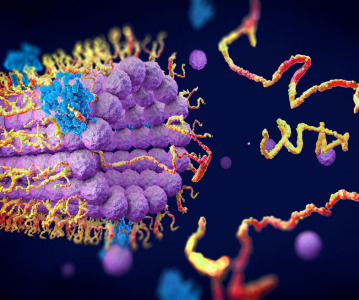Will Innovations in Biomarkers Lead to a Paradigm Shift in Drug Discovery?

With the efficacy for most drugs targeting severe therapeutic indications ranging from a meagre 25% to 50%, there is a tremendous market for biomarkers. Thus far, drugs have been administered without knowing if they will work for a specific patient. Biomarkers are now being used in the first stages of drug development to provide suitable signals in in vitro or animal trials to indicate if a specific compound will have high or low efficacy in humans. This means that researchers can discard ineffective candidates during the initial stages of drug development itself.
New analysis from Frost & Sullivan, Analysis of the Western European Biomarkers Market in Drug Discovery and Development, studies the developments in the genomics, proteomics, metabolomics and imaging segments across Western Europe: the UK, Germany, France, Italy and Spain as well as the Benelux and Scandinavian countries. The research finds that the market earned revenues of $1.44 billion in 2013 and estimates this to reach $3.54 billion in 2020.
“Besides genomics- and proteomics-based platforms, market participants are employing other ‘omics’ platforms such as glycomics, lipidomics, metabolomics and immunomics for biomarker discovery,” said Frost & Sullivan Healthcare Senior Research Analyst Srinivas Sashidhar. “With advancements being made in analytical methods for biomarker detection and integration capabilities, the discovery and use of biomarkers in clinics will rise substantially.”
Developments in nanotechnology are enabling the production of a large number of nanoparticle-based biomarker detection systems, including microarrays and nanoarrays for genetic-related applications. Further, research infrastructures are fostering multidisciplinary interaction, such as the merging of genomics-related disciplines that enable correlations between individuals, genetic profiles, and drug responses. In the long term, advanced computational tool applications that integrate large omics data will emerge, creating the need for necessary maintenance infrastructure.
However, the complex nature of resource-driven biomarker validation studies delays the process of finding results. Large-scale validation studies of candidates also pose considerable logistical and regulatory challenges. These are expected to reduce once best practices for analytic validation of various analytes/platforms are developed and more standardised regulatory protocols and parameters for assay validation are introduced.
Market participants will find extensive demand for biomarkers in patient stratification applications, particularly for cardiac and neurological disorders. Accurate risk assessment with a high predictive value can help reduce the overall incidence of cardiovascular diseases. The quest is already on for protein and metabolomic signatures. In fact, some biomarkers, such as natriuretic peptides and B-type natriuretic peptides and their amino-terminal propeptide equivalent, N-terminal-proBNP, which is indicative of stress, is being actively explored as a means of guiding therapy.
“Diagnostic developers and pharmaceutical companies could enter partnerships and strike licensing deals to reduce drug development costs and prevent late-stage failures that are especially common when it comes to cancer,” stated Sashidhar. “Not only will these strategic collaborations enable the quick commercialization of drugs, it will also help bring in theranostic platforms to monitor drug responses.”
Related News
-
News A Day in the Life of a Start-Up Founder and CEO
At CPHI we work to support Start-Up companies in the pharmaceutical industry and recognise the expertise and innovative angles they bring to the field. Through our Start-Up Programme we have gotten to know some of these leaders, and in this Day in the ... -
News Biopharmaceutical manufacturing boost part of new UK government budget
In their national budget announced by the UK Labour Party, biopharmaceutical production and manufacturing are set to receive a significant boost in capital grants through the Life Sciences Innovative Manufacturing Fund (LSIMF). -
News CPHI Podcast Series: The power of proteins in antibody drug development
In the latest episode of the CPHI Podcast Series, Lucy Chard is joined by Thomas Cornell from Abzena to discuss protein engineering for drug design and development. -
News Amgen sues Samsung biologics unit over biosimilar for bone disease
Samsung Bioepis, the biologics unit of Samsung, has been issued a lawsuit brought forth by Amgen over proposed biosimilars of Amgen’s bone drugs Prolia and Xgeva. -
News CPHI Podcast Series: Why we need to consider women in clinical trials
The latest episode of the CPHI Podcast Series with Lucy Chard covers women's health, specifically women's representation in clinical trials, the associated bias, and the impacts on health for this population. -
News US FDA does not approve MDMA therapy for PTSD, requests more data
The MDMA-based therapeutic developed by Lykos Therapeutics, a California-based Public Benefit Corporation (PBC), has been reviewed and unapproved by the US FDA. The regulator has requested additional phase III trial data for further safety and efficacy... -
News Novartis and Viatris latest facing lawsuit over HeLa cell misuse
Global pharmaceutical companies Novartis and Viatris are the latest hit with a lawsuit claim pertaining to alleged misuse of the ‘HeLa’ cell line from the estate of woman whose cancerous tissue cells were taken without consent. -
News Sanofi invests billions into Frankfurt insulin production site
French pharmaceutical company Sanofi have announced an investment of EUR1.3 billion at their existing BioCampus site in Frankfurt am Main for the expansion of insulin production.
Position your company at the heart of the global Pharma industry with a CPHI Online membership
-
Your products and solutions visible to thousands of visitors within the largest Pharma marketplace
-
Generate high-quality, engaged leads for your business, all year round
-
Promote your business as the industry’s thought-leader by hosting your reports, brochures and videos within your profile
-
Your company’s profile boosted at all participating CPHI events
-
An easy-to-use platform with a detailed dashboard showing your leads and performance



.png)

.png)
.png)
.png)